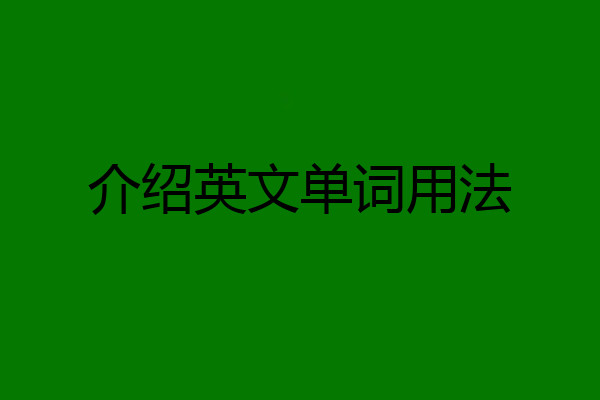
布川依夫
“自我介绍”用英语表达是: self-introduction
单词: self-introduction
音标: 英 ['selfɪntrəd'ʌkʃn] 美 ['selfɪntrəd'ʌkʃn]
释义: 自我介绍
这是一个合成词, 由self 和introduction合成, 作为名词使用。
例如: 做一个自我介绍
翻译为: make a self-introduction
扩展资料
例句
1、The first question: Please do a self-introduction in English.
第一个问题:请用英语做一个自我介绍。
2、As a freshman, it is my first time to say hello and do some self-introduction to everybody here.
一年级学生,这是我第一次来打个招呼,并做一些自我介绍,每个人都在这里。
3、Thank you for your invitation. Allow me to make a self-introduction.
谢谢你的邀请,请允许我做自我介绍。
4、Can you give us a little self-introduction about yourself as an artist and what kind of music you write?
你能不能自我介绍一下,告诉我们一点关于你的音乐背景和作曲风格?
5、First of all, to be a self-introduction it, I was general manager of the company's ideas.
首先做个自我介绍吧,本人是点子公司的总经理。


兔了里个酱酱
只能用invented,因为是已经邀请了的。。。而且这句话也有点毛病,下面修改:Mostoftheartists(thatwere)inventedtothepartywerefromSouthAfrica. 在这里invented是被动词,整句意思为:大多数被邀请到派对的艺术家都是从南非来的

安好即可
spend,cost,take和pay的区别是历年中考试题的必考内容之一,虽然它们都可以表示“花费”,但用法却不尽相同。 spend的主语必须是人, 常用于以下结构:(1) spend time /money on sth. 在……上花费时间(金钱)。例:I spent two hours on this maths problem. 这道数学题花了我两个小时。(2) spend time / money (in) doing sth. 花费时间(金钱)做某事。例:They spent two years (in) building this bridge. 造这座桥花了他们两年时间。(3)spend money for sth. 花钱买……。例:His money was spent for books. 他的钱用来买书了。 cost的主语是物或某种活动, 还可以表示“值”, 常见用法如下:(1)sth. costs (sb.) +金钱,某物花了(某人)多少钱。例:A new computer costs a lot of money. 买一台新电脑要花一大笔钱。(2) (doing) sth. costs (sb.) +时间,某物(做某事)花了(某人)多少时间。例:Remembering these new words cost him a lot of time. 他花了大量时间才记住了这些单词。 注意:cost的过去式及过去分词都是cost,并且不能用于被动句。 take后面常跟双宾语, 常见用法有以下几种:(1) It takes sb. +时间+to do sth. 做某事花了某人多少时间。例:It took them three years to build this road. 他们用了三年时间修完了这条路。(2)doing sth. takes sb. +时间,做某事花了某人多少时间。例:Repairing this car took him the whole afternoon. 他花了一下午修车。 pay的基本用法是:(1) pay (sb.) money for sth. 付钱(给某人)买……。例:I have to pay them 20 pounds for this room each month. 我每个月要付20英磅的房租。(2)pay for sth. 付……的钱。例:I have to pay for the book lost. 我不得不赔丢失的书款。(3)pay for sb. 替某人付钱。例:Don?蒺t worry!I'll pay for you. 别担心, 我会给你付钱的。(4)pay sb. 付钱给某人。 例: They pay us every month.他们每月给我们报酬。(5)pay money back 还钱。例:May I borrow 12 yuan from you? I'll pay it back next week. 你能借给我12块钱吗?下周还你。(6)pay off one's money还清钱。 spend/cost/pay/take (1)spend的主语通常是人,往往用于以下句型: (sb)spend some money/some time on sth. (sb)spend some money/some time(in)doing sth.例如: I spent fifty yuan on the coat. = I spent fifty yuan (in) buying the coat. 我花50元买了这件大衣。 He spent three days on the work. = He spend three days (in) doing the work. 我干这项工作用了3天。 (2)take常用于“占用、花费”时间,其主语通常为形式主语“it”或物。句式是: It takes/took sb.some time to do sth=Sth.takes sb.some time. 例如: It took me three years to draw the beautiful horses. 画这些漂亮的马花费了我3年时间。 The work will take me two days.这项工作花了2天时间。 (3) pay为“付款、赔偿”之意,主语通常是人,往往是sb. pays some money for sth或pay sb.(some money for sth) 例如: I paid fifty yuan for the coat.我花50元买了这件大衣。 He has paid the doctor 50 pounds for the medicine? 他买药已付医生50英镑。 How much did you pay him? 你付他多少钱? (4) cost的主语必须是某物。spend … on sth./in doing sth.的主语必须是人。pay … for 的主语也是人。It takes + sb.+ 时间(或钱)to do sth.的主语则必须是形式主语It。 动词cost的常用用法是sth.cost (sb.) some money。 如:The dictionary cost me £ 20.

飞花叶叶雪
either与neither可用作形容词、代词、副词和连词等,它们的用法如下:一、用作形容词。起定语作用,常放在单数名词前。either表示“这个或者那个”;neither表示“既非这个、也非那个,两者皆非的”。如:Youmayuseeitherbook.两本书你可以随便用一本。Neitheranswerisright.两个答案都不对。二、用作代词。范围多限定于两者之间,常用作主语。作主语时后面跟单数动词。either表示“二者之一”;neither表示“两者都不”,其反义词是both。如:Eitheroftheknivesisuseful.两把刀都有用。Neitherofthemwasingoodhealth,butbothworkedveryhard.他们两人身体都不好,但都努力地工作。三、用作副词。either只用于否定句中,表示“也(不)”;neither通常用在句子(或简略答语)的开头,表示“也不”,其后要用倒装语序(即:将主语放在助动词、情态动词、连系动词be之后)。如:Idon’tspeakFrench.Shedoesn’t,either.(=NeitherInorshespeaksFrench.)我不会讲法语,她也不会讲法语。Ifshewon’tgo,neithershallI.(=Ifshewon’tgo,Iwon’t,either.)要是她不去,我也不去。四、用作连词。构成短语either…or…与neither…nor…,分别表示“要么……要么……,或者……或者……”和“既不……也不……,既非……也非……”。常用来连接两个并列成分,如并列主语、并列谓语等。但应注意以下几点:1.无论either…or…还是neither…nor…,在连接两个并列的单数名词作主语时,后面动词用单数。2.若连接两个复数名词作主语,后面动词用复数。3.如果一个单数名词和一个复数名词一起作主语时,动词的单复数形式必须和最靠近的一个主语保持一致。人称代词作主语也一样。如:EitherMaryorRoseiscoming.不是玛丽来,就是罗斯来。(连接两个并列的单数主语)Neitherboystudentsnorgirlstudentsareright.男生和女生都不对。(连接两个并列的复数主语)NeithertheteachernorthestudentsaregoingtoHuashan.老师和同学们都不打算去华山。(动词与最靠近的主语相一致)Youcaneitherrideabikeortakeabustogothere.你可以骑车或坐公共汽车去那里。(连接并列谓语)Ihaveneithertimenormoneyforskiing.我没有时间,也没有钱去滑雪。(连接并列宾语)Thegreenshirtiseitheryoursorhers.这件绿色的衬衣不是你的就是她的。(连接并列表语)Hewillcomeneithertodaynortomorrow.他今天不会来,明天也不会来。(连接两个状语)

mujiontheway
youth我们在使用的时候要注意它所表示的是否可数,及其它的一些相关的`用法介绍。
注意以下用法及其可数性:
1. 表示“青春”,是不可数名词 。如:
She lost (kept) her youth. 她青春不再(青春依旧)。
2. 表示“青年时代”、“年轻时候”,是不可数名词 。如:
I often went there in my youth. 我小时候常去那儿。
At the party I met a friend of my youth. 在晚会上我遇到了一个我年轻时候的朋友。
3. 表示“青年人”,有两种用法:
(1) 用作个体名词(可数),主要用来指男青年而不指女青年。如:
As a youth he showed little promise. 他这个小伙子看不出有什么出息。
Several youths and girls were standing at street corner. 有几个小伙子和姑娘站在街道拐角处。
注:这样用的 youth 有时带有贬义。如:
The police are looking for five youths (=five people). 警察正在找五个青年人。
(2) 用作集合名词,表整体(可指男女青年),用作主语时谓语可用单数或复数。如:
The youth of today is [are] fond of dancing. 现在的年青人都喜欢跳舞。
The youth of the country is [are] ready to fight. 全国的青年都准备战斗。
优质英语培训问答知识库